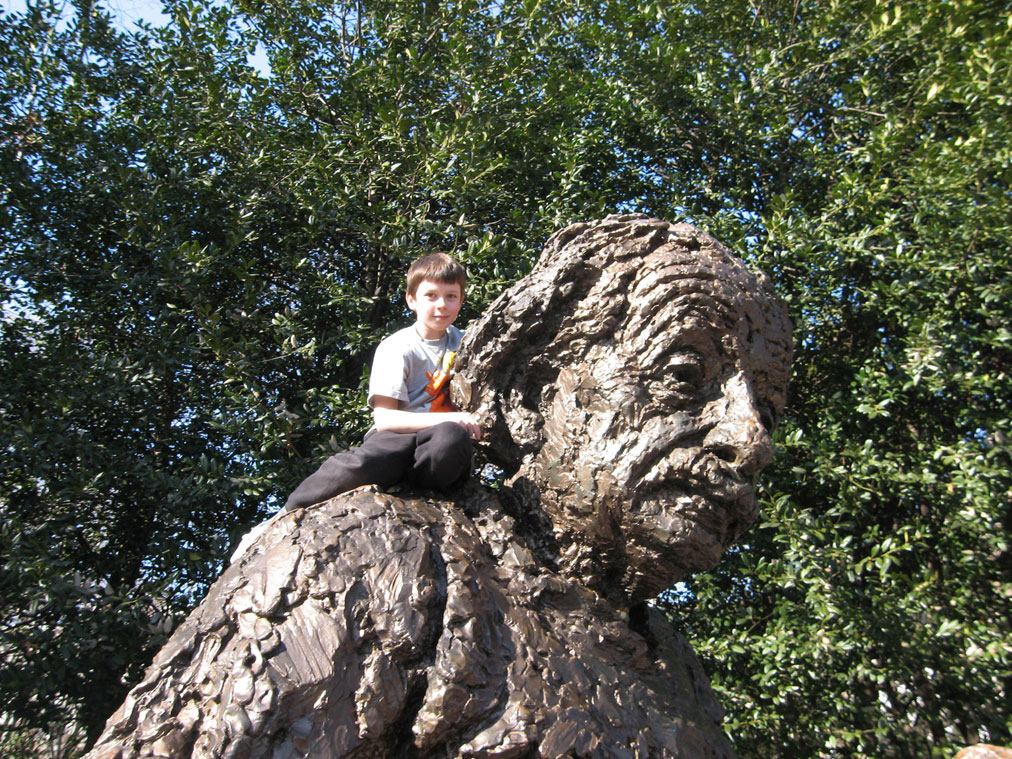Concept Development: On the Shoulders of Giants
Two-Page Timeline, Presentation and Annotated References
If I have seen further it is only by standing on ye shoulders of
giants.
[Isaac Newton in a Letter to Robert Hooke, dated
5 February 1675]

Einstein and Leisureguy's (Michael Han) grandson. Posted
March 23, 2007.
http://leisureguy.wordpress.com/2007/03/23/on-the-shoulders-of-giants/
You may work alone or with one other person.
Three-Page Timeline
Create an attractive and publication-quality historical timeline.
Provide as complete as possible a listing of the major discoveries or ideas
in the mathematical topic you have had approved by message on ASULearn
and present the listing in an attractive display. A maximum of three pages
(not including references, which are as long as needed)
will be allowed so that someone else can quickly read your timeline and
obtain a basic understanding of the events. The result should
be an in depth exploration of the important and interesting
events in the history of a specific topic as related to geometry - not
the entire history. Be sure to include recent information or applications
related to your topic as well as contributions from diverse cultures and
civilizations.
Approximate dates can be noted as ~1762 or by a range of dates, such
as 1700-1800, or by notations like 18th century.
Annotated Bibliography
Use many different types of sources, including scholarly references
and library sources.
Submit an annotated bibliography of all
of the sources you used in the timeline, with annotations explaining
how you used each reference in your timeline, where the pictures came from,
etc. Use as many pages as you need for the annotated bibliography.
Turn in an electronic version of your timeline and references
in Adobe acrobat pdf format to the personal storage space on ASULearn.
On a Mac you can print to a pdf file. I will make your pdf publicly available.
Research Session Presentations
The presentation sessions are similar to
research day at Appalachian, poster presentations at research conferences,
or science fairs.
Bring a printed version to class to post on the wall [I will bring
tape].
We will divide the class into two sessions (half the class will
stand next to the timeline as the other half examines them, and then we will
switch roles). During your
session, you must stand by your timeline to discuss your topic
and answer questions. If you work with another person, they will be in the
other session so you should be prepared to present the entire project.
When you are viewing other timelines, you will
conduct peer review:
1) Name of the person and the topic.
2) List a few positive aspects of the project.
3) Provide suggestions for improvement for the timeline.
4) Provide suggestions for improvement for the presentation.
5) Invent a question about the project. List the question and the
person's answer.
Here is a sample
timeline from first
year seminar and a
timeline from linear algebra (both satisfied different criteria).
Topics
The topic you choose will be one that you revisit in the final topic, so
choose a topic that you are interested in:
History of area
History of axiomatic systems
History of coordinate geometry
History of geometric constructions
History of geometric transformations
History of parallel postulate
History of perimeter and circumference
History of polyhedra
History of similarity
History of volume
Your topic will be approved on a first-come-first-served
basis as a message to me on ASULearn.
There is a maximum of
2 people per topic (you can work individually or together).
References and Suggestions
Library books or books in my office contain
a wealth of historical information.
The CD
entitled "Historical Modules for the Teaching and Learning of Mathematics"
(Katz and Michalowicz, 2004) contains many modules
of historical content and is also
available for you to look at in my
office hours.
Websites such as the
MacTutor History of Mathematics archive (O'Connor and Robertson, 2005)
provide an
extensive collection of articles on particular people and topics and
you can perform a site search there.
The
Earliest Known Uses of
Some of the Words of Mathematics (Miller, J, 2008)
can provide history on the development as well as the first published
appearance of terms such as the
Klein bottle.
Other pages, such as
Wikipedia's
History of geometry can also be useful.
Some topic searches may yield many unrelated pages or be too general -
like the history of area {which means a variety of notions in real-life}
so modifying a search to look for more specific inforamtion -
for example searching for a geometric object - might be helpful.
Similarly,
the history of similarity might be too general a search. A
modified search such as
the
history of "similar triangles" can be more productive and it
leads to a mathematics history journal article
Proportionality in Similar Triangles: A Cross-Cultural Comparison
As always, I am happy to help in office hours or on ASULearn.
